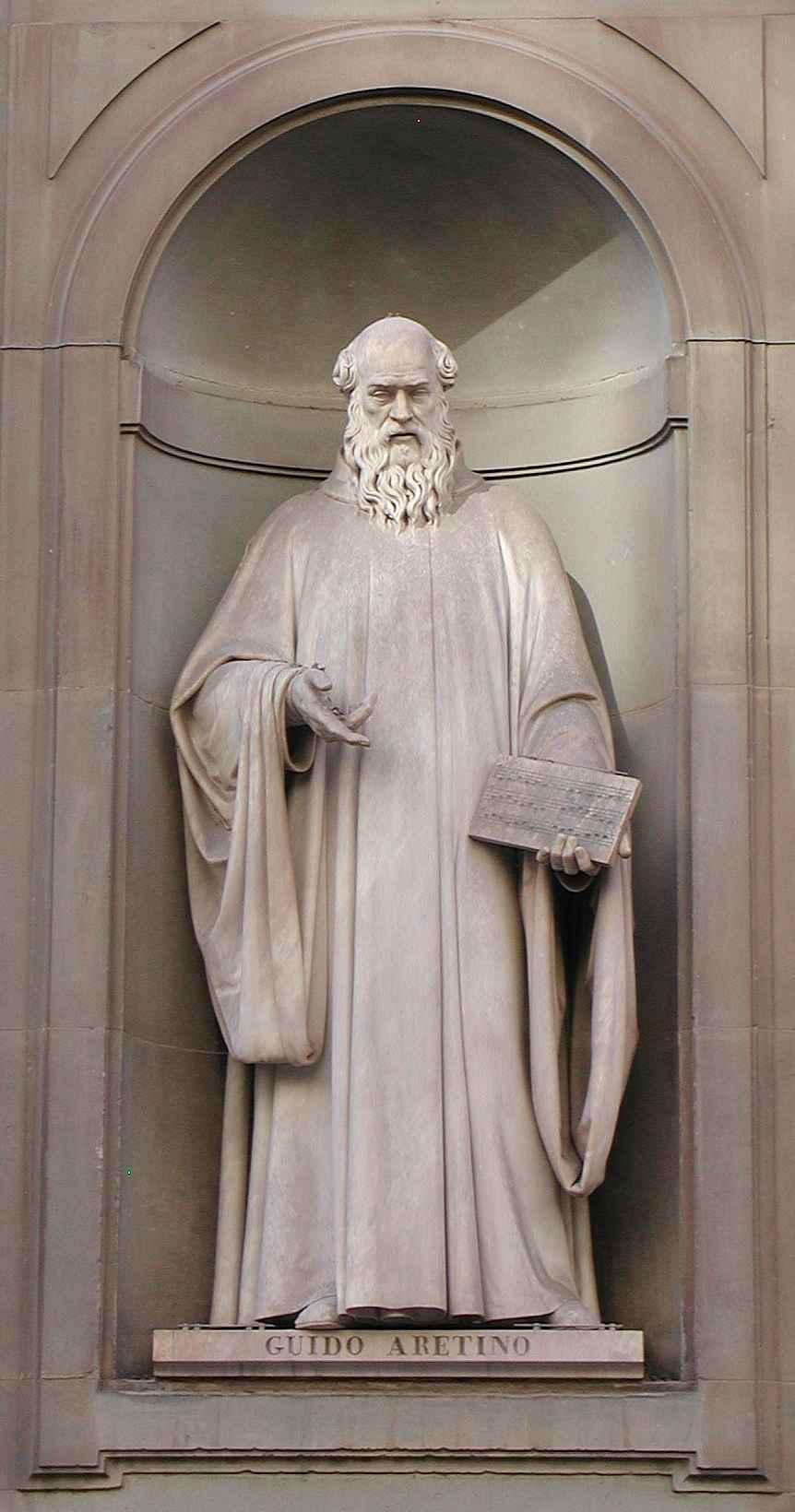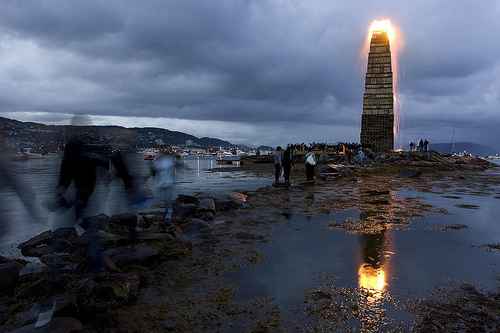
There are few hymns so famous in the holy liturgy as that of the First Vespers of this Feast, Ut Queant Laxis. Its composition is attributed to Paul the Deacon, a monk of Monte Casino, in the 8th century; and the story attached to it is particularly touching. Honored with the sacred order of Deacon, the title of which remains, through the ages, inseparably linked with his name, Paul Warnefrid, the friend of St. Karl the Great (Charlemagne) and the historian of the Lombards, was on a certain occasion deputed to carry the paschal candle. Now it happened that, whilst he was preparing himself for this function, the most solemn of those reserved to the Levites of the New Testament (Deacons), he suddenly lost his voice, until then clear and sonorous, so that he was powerless to sound forth the glad notes of the Exsultet. In this extremity, Paul recollected himself; and turning to St. John, patron of the Lombard nation and of that Church built by St. Benedict at the top of the holy mount, he invoked him whose birth had put stop to the dumbness of his own father, and who still preserves his power of restoring to vocal chords their lost suppleness. The son of Zachary heard his devout client. Such was the origin of the harmonious strophes which now form the three hymns proper to this feast.
What is still better known is the importance which the first of these strophes has acquired in the history of Gregorian chant and music. The primitive air to which the hymn of Paul the Deacon was sung possessed this peculiarity – that the initial syllable of each phrase rose just one degree higher than the preceding in the scale of sounds; thus was obtained, on bringing them together, the series of fundamental notes which form the basis of our present scale. The custom was afterwards introduced of giving to the notes themselves the names of these syllables: Ut queant laxis resonare fibris, Mira gestorum famuli tuorum, Solvi polluti labii reatum, Sancte Ioannes (Ut, Re, Mi, Fa, Sol, La). The monk Guido of Arezzo, in his method of teaching, originated this custom; and by completing it with the introduction of the regular lines of the musical scale, he caused an immense stride to be made in the science of sacred music, until then so laborious to render and so tedious to acquire. (Eventually Ut became Do, and Ti was added to make our modern scale. Ti was originally SI – the first letters of "Sancte Ioannes.") He thus acknowledged the honor due to the divine Precursor, St. John the Baptist – to the Voice whose accents reveal to the world the harmony of the eternal canticle: namely, that the organization of earth's melodies should be forever attached to his name.

Guido of Arezzo
What would it be like if, going back to former days, we were able to take our share in the olden manifestations of Catholic instinct on this Feast! In those grand ages wherein popular piety followed with docile step the inspiration of the Church, such demonstrations suggested by a common Faith, on the recurrence of each beloved anniversary, kept alive in every breast the understanding of the divine work and its mystic harmonies thus beautifully displayed in the liturgical cycle. Nowadays, when the liturgical spirit has fallen to a lower standard in the minds of the multitude, the Catholic verve, which used to urge on the mass of the people, is no longer felt. We are far from the days when two rival armies, meeting face to face on St. John's eve, would put off the battle till the day after the Feast (e.g. the Battle of Fontenay, June 25, 841).
The Faith of our fathers never ignored the great benefits for which both individuals and nations are indebted to St. John. So many neophytes received his name in Baptism, so efficacious was the aid afforded by him in conducting his clients to sanctity, that there is not a day in the calendar on which there may not be honored the heavenly birthday of one or other so named (Annus Joannis, Prague 1664). Amongst nations, the Lombards formerly claimed St. John as patron, and French Canada does the same to this day. But whether in East or West, who could count the countries, towns, religious families, abbeys and churches placed under his powerful patronage: from the temple which, under Theodosius, replaced that of the ancient Serapis in Alexandria with its famous mysteries, to the sanctuary raised upon the ruins of the altar of Apollo on the summit of Monte Cassino by St. Benedict; from the 15 churches in Byzantium, the new Rome, consecrated within her walls in honor of the Precursor, to the august Basilica of the Lateran, well worthy of its epithet the golden Basilica, which in the Capital of Christendom remains forever the mother and mistress of all churches, not only of the city, but of the whole world!
The fast of St. John's Vigil is no longer of precept. Formerly, however, not one day's fasting only, but an entire Lent was observed at the approach of the Nativity of the Precursor, resembling in its length and severity that of the Advent of Our Lord. After seeing the penance of St. John's fast equaled to the austerity of that preceding Christmas, it is not surprising to behold the Church in Her Liturgy making the two Nativities closely resemble one another.
The Nativity of St. John, like that of Our Lord, was celebrated by three Masses: the first, in the dead of night, commemorated his title of Precursor; the second, at daybreak, honored the baptism he conferred; the third, at the hour of Terce, hailed his sanctity. In like manner, as there were formerly two Matins on Christmas night, so, in many places, a double Office was celebrated on the Feast of St. John. The first Office began at the decline of day on the 23rd; it was without Alleluia, in order to signify the time of the Law and the Prophets which lasted up to St. John. The second Office, begun in the middle of the night, terminated at dawn; this was sung with Alleluia, to denote the opening of the time of grace and of the kingdom of God.
Joy, which is the characteristic of this Feast, outstripped the limits of the sacred precincts and shed itself abroad, as far even as the infidel Muslims. Whereas at Christmas the severity of the season necessarily confined to the domestic hearth most touching expansions of private piety, the lovely summer nights at St. John's Tide gave free scope to popular display of lively faith among various nationalities. Scarcely had the last rays of the setting sun died away, than all the world over, from the far East to the farthest West, immense columns of flame arose from every mountain top; and, in an instant, every town and village and smallest hamlet was lit up. "St. John's fires," as they were called were an authentic testimony, repeating over and over again the truth of the words of the Angel and of prophecy, that universal gladness was to hail the birthday of St. Elizabeth's son (Luke 1: 14).

St. John's bonfires are still observed in many parts of the world, even in Protestant Scandinavia.
It may almost be said of the "St. John's fires," that they date, like the festival itself, from the very beginning of Christianity, but not indeed without sometimes exciting the anxious attention of the Fathers and Councils, ever on the watch to banish every superstitious notion from manifestations, which otherwise so happily began to replace the pagan festivities proper to the solstices. But the necessity of combating some abuses, which are just as possible in our own days as in those, did not withhold the Church from encouraging a species of demonstration which so well answered to the very character of the Feast. "St. John's fires" made a happy completion to the liturgical solemnity; testifying how one and the same thought possessed the mind both of holy Church and of the terrestrial city; for the organizations of these rejoicings originated with the civil corporations, and the expenses were defrayed by the municipalities. Thus the privilege of lighting the bonfire was usually reserved to some dignitary of the civil order. Kings themselves, taking part in the common merry-making, would esteem it an honor to give this signal to popular gladness; Louis XIV, as late as 1648, lit the bonfire on the "place de Grève," as his predecessors had done. In other places, the clergy were invited to bless the piles of wood, and to cast thereon the first brand; whilst the crowd, bearing flaming torches, would disperse over the neighboring country, amidst ripening crops, or would march along the coast, following the tortuous cliff-paths, shouting for joy, and the adjacent islands would reply by lighting up their festive fires.
In some parts the custom prevailed of rolling a burning wheel; this was a self-revolving red-hot disk, rolling along the streets or down from the hilltop, to represent the movement of the sun, which attains the highest point in its orbit, to begin at once its descent – thus was the word of the Precursor brought to mind. When speaking of the Messias, he says: "He must increase, and I must decrease" (John 3: 30). The symbolism was completed by the custom, then in vogue, of burning old bones and rubbish on this day which proclaims the end of the ancient law and the beginning of the New Covenant, according to the Holy Scripture, where it is written: "And new store coming on, you shall cast away the old" (Lev. 26: 10). Blessed are the people amongst whom is still preserved something of such customs, whence the simplicity of our forefathers drew a gladness more true and more pure than their descendants seek in festivities wherein the soul has no part!
Contact us: smr@salvemariaregina.info
Visit also: www.marienfried.com